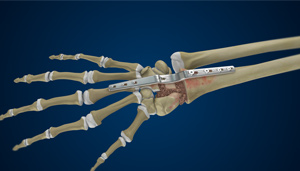Total Wrist Arthrodesis

Arthrodesis is the surgical immobilization of a joint by the fusion of the adjacent bones.
Total wrist arthrodesis, also known as wrist fusion is a surgical procedure in which the wrist joint is stabilized or immobilized by fusing the forearm bone (radius) with the small bones of the wrist.
Arthrodesis is done to relieve the pain after severe trauma to the wrist. A painful wrist causes disability and affects function of the upper extremity.
The wrist joint is one of the most complex joints in the human body. Numerous joints and bones contribute to the strength and stability of the wrist. The wrist is made up of eight separate small bones called carpal bones. The carpal bones connect the two bones of the forearm, the radius and the ulna, to the bones of the hand. The metacarpal bones are the long bones that lie within the palm that attach to the phalanges, the bones in the fingers and thumb.
Articular cartilage is the white tissue lining the ends of bones where the bones connect to form joints. Cartilage acts as cushioning material and helps in smooth gliding of bones during movement. An injury to the joint may damage this cartilage causing severe pain and inflammation, known as degenerative arthritis.
Indications
Total wrist arthrodesis may be recommended by your doctor when conservative treatments such as rest, medications, injections and physical therapy do not relieve the pain.
Indications for the surgery include:
- Advanced symptomatic arthritis secondary to a degenerative, post-traumatic, inflammatory, or post-infectious condition
- Wrist trauma and instability
- Joint destruction due to tumours
- Correction of wrist deformities in patients with spastic hemiplegia
- Unsuccessful wrist reconstruction or arthroplasty with or without joint replacement
Evaluation and Diagnosis
Your orthopaedic surgeon will gather your medical history and perform a physical examination of the wrist. Diagnostic studies will be carried out and may include:
- X-rays to investigate bony structures of the joint.
- MRI scans to generate images of both bone and soft tissues.
- CT (Computed tomography) scans to evaluate the wrist bones in detail which is difficult to view on a plain radiograph.
Surgery
Various techniques are in practice for achieving a successful arthrodesis. The type of operative technique depends on the underlying condition, quality of bone, condition of the remaining joints of the involved extremity, and the surgeon’s preference.
Procedure
Total wrist arthrodesis is usually performed under general anaesthesia. Your surgeon makes an incision on the back of the wrist. This type of incision decreases the chances of damage to the blood vessels and nerves. The soft tissues are retracted to gain access to the bones and joints of the wrist. Any articular cartilage present is removed from each joint to be fused and a bone graft (derived from the end of the radius bone) is used to replace the lost cartilage.
A metal plate with screw holes is placed over the back of the wrist. The plate extends from the radius to the metacarpal bone of the middle finger and is attached to the bone with metal screws. The plate holds the bones in the proper position and ensures they stay together during the healing process. The plate remains in the body and is not removed unless it is causing problems.
At the end of the procedure, the incisions are closed with sutures.
Post-operative care
The post-surgical instructions to follow depend on the type of repair performed.
Some of the instructions include:
Take medications as prescribed by your doctor to help alleviate pain and make you comfortable.
Take medications as prescribed by your doctor to help alleviate pain and make you comfortable.
Risks and Complications
As with any major surgery, there are potential risks involved with total wrist arthrodesis. Complications can occur following total wrist arthrodesis and include:
- Infection
- Excess bleeding
- Damage to blood vessels
- Nerve injury
- Problems with instrumentation
- Failure of bone fusion (non-union)Wrist arthrodesis is a surgical procedure to relieve wrist pain that does not respond to conservative treatment measures and continues to affect a patient’s quality of life. It results in a high degree of patient satisfaction with respect to pain relief as well as correction of deformity.
Wrist arthrodesis is a surgical procedure to relieve wrist pain that does not respond to conservative treatment measures and continues to affect a patient’s quality of life. It results in a high degree of patient satisfaction with respect to pain relief as well as correction of deformity.
Other Hand & Wrist List
- Wrist Joint Replacement
- Trapeziectomy + LRTI
- Hand Tendon Release
- ORIF
- Vascularized Bone Grafting
- Wrist Ligament Reconstruction
- Tendon Reconstruction
- Microsurgery Nerve Repair/Nerve Grafting
- Arthroscopic Wrist Surgery
- Arthroscopic Ganglion Excision
- Collagenase Injection
- Excision of Tumour
- Fasciectomy
- Carpal Tunnel Release

 Menu
Menu






